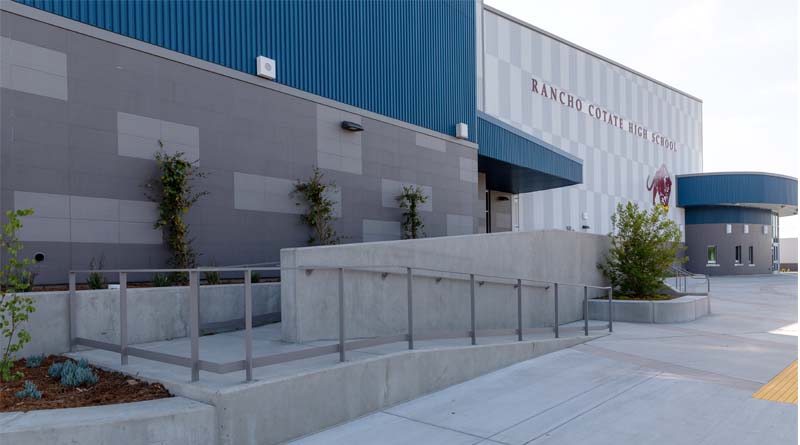By Lisa Kopochinski
ROHNERT PARK, Calif.— The new $52 million, 75,000-square-foot collegiate-level facility Rancho Cotate High School Theater/Academic/Gymnasium (TAG) Building in Rohnert Park is now complete after two years.
The idea for this TAG building was conceived with the intent to create a state-of-the-art performing arts, athletic, and academic facility to continue to improve student achievement.
The master plan for this project—completed by WLC Architects in 2014 for the Cotati-Rohnert Park Unified School District—ultimately envisioned an entirely new Rancho Cotate High School to serve the community for the next 100 years. The TAG building is the first step and an integral part of the master planned new high school.
The general contractor on this project was Wright Contracting of Santa Rosa. The building is being paid for by two facility bonds, including $42 million from an $80 million bond that voters approved in 2014, and $10 million from a bond offering that was approved in 2016.
“It’s the largest facility of its kind in Northern California,” says Interim Superintendent Tony Roehrick said. “Whether you’re interested in the tech field or theater arts or athletics, this is going to provide you with first-class facilities.”
Rancho Cotate has approximately 1,500 students, which is approximately 600 fewer students than enrollment 20 years ago. District officials hope this new building will attract more students to attend Cotati-Rohnert Park schools.
In an effort to attract more families to this area and school, Principal Louis Ganzler has been the district’s voice for radio ads. He has also conducted more than 50 tours in the past few months to interested parents and community members, in addition to a number of realtors who have found this school to be a great selling point for the area.
“Every person I’ve brought here has essentially expressed some level of awe,” says Ganzler. “Part of what this building allows us to do is build programs.”
For instance, next year’s freshmen will have the opportunity to choose from one of five new academic concentrations—law and justice; film; computer science; biomedical sciences and sports careers.
The school’s performing arts program is expected to be strong too. Drawing inspiration from the Green Music Center at Sonoma State University—whose performance hall opens to the lawn at the rear of the building—the reversible stage incorporated in this building opens to one of the largest gymnasiums in Northern California. The acoustically tuned 250-seat formal theater will provide a beautiful venue for student, community and professional performances on campus through multiple disciplines—orchestral performance, spoken word, live music, drama performance or projected media.
The new Henry J. Sarlatte Gymnasium will be a centerpiece for school sports and community functions with 2,000 seats available in the built-in bleachers. With a maximum capacity of nearly 3,000 people, the space can accommodate concerts, awards ceremonies, graduations and guest performances with the use of movable seating and setup.
Sporting a regulation NCAA-sized basketball center court and volleyball court, the gymnasium is outfitted to host multiple sports under one roof. The gym features volleyball practice courts, basketball practice courts, badminton courts, multiple full-sized wrestling mats—all set for hosting local and state competitions on campus. Full locker rooms for home and away teams add to the hosting capabilities for sports throughout the year.
Apart from the theater and gymnasium, additional classroom spaces provides for more student offerings. An acoustically-tuned, recording-ready music room gives the band a unique space to rehearse—coupled with three practice rooms, each with recording capabilities.
Four audio-visual classrooms and a full video lab provide opportunities for students to create with professional tools. Print media, Photoshop and digital arts—in addition to audio and video production—are all available for student use. The ability to produce content in-house and provide media packages to the school and community allows students to communicate through different mediums.
Jason Dawes, who teaches filmmaking at the school, says the green room, editing room and labs were comparable to what professionals use.
“I think of it as more of a really amazing facility.”


